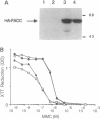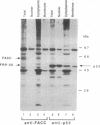Abstract
Fanconi anemia (FA) is an autosomal recessive disease characterized by congenital anomalies, aplastic anemia, and chromosomal instability. A cDNA encoding the FA complementation group C (FACC) polypeptide was recently cloned [Strathdee, C. A., Gavish, H., Shannon, W. R. & Buchwald, M. (1992) Nature (London) 356, 763-767]. To further characterize this polypeptide, we generated a rabbit polyclonal antiserum against its carboxyl terminus. We used this antiserum to analyze the FACC polypeptide from normal or mutant (FA) lymphoblast cell lines. By immunoprecipitation, the wild-type FACC was a 60-kDa protein, consistent with its predicted molecular mass. FA group C cell lines expressed full-length FACC, truncated FACC, or no detectable FACC polypeptide. In addition, the antiserum specifically immunoprecipitated a 50-kDa and a 150-kDa FACC-related protein (FRP-50 and FRP-150). Unexpectedly, cell fractionation and immunofluorescence studies demonstrated that the FACC polypeptide localizes to the cytoplasm. In conclusion, we have generated an antiserum specific for the human FACC polypeptide. The antiserum should be useful for screening FA cells for mutant FACC polypeptides and for identifying and cloning FACC-related proteins.
Full text
PDF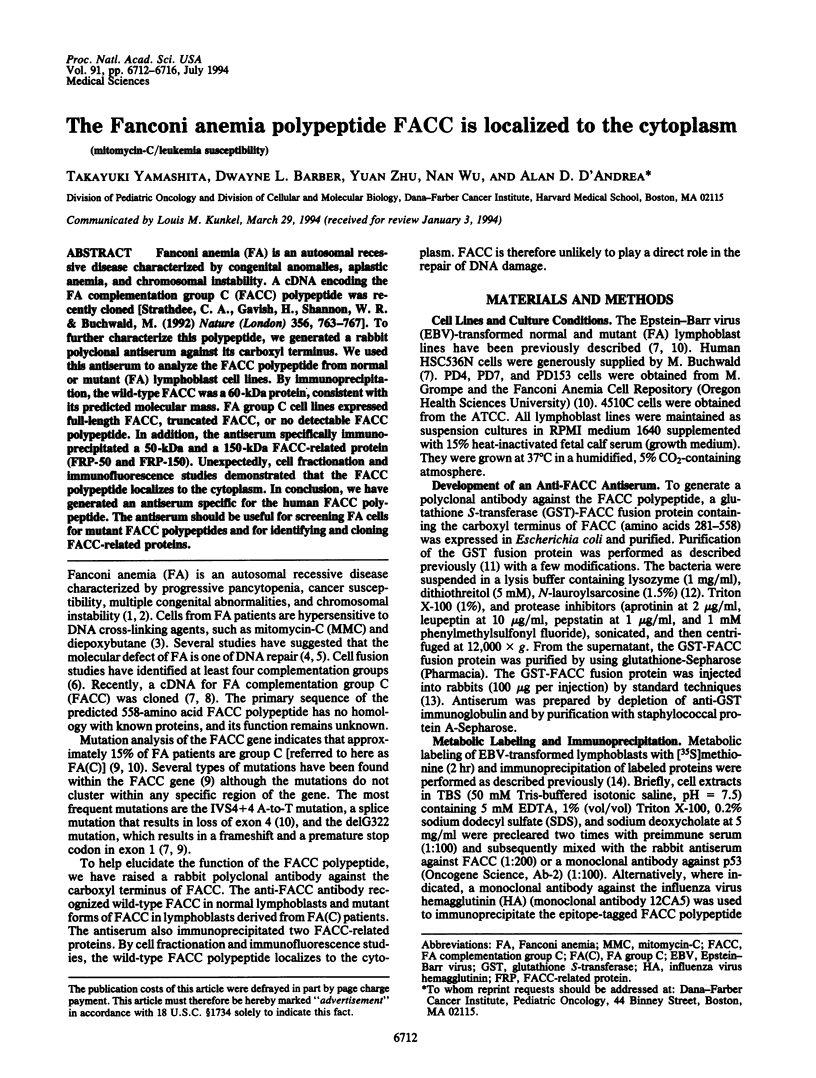
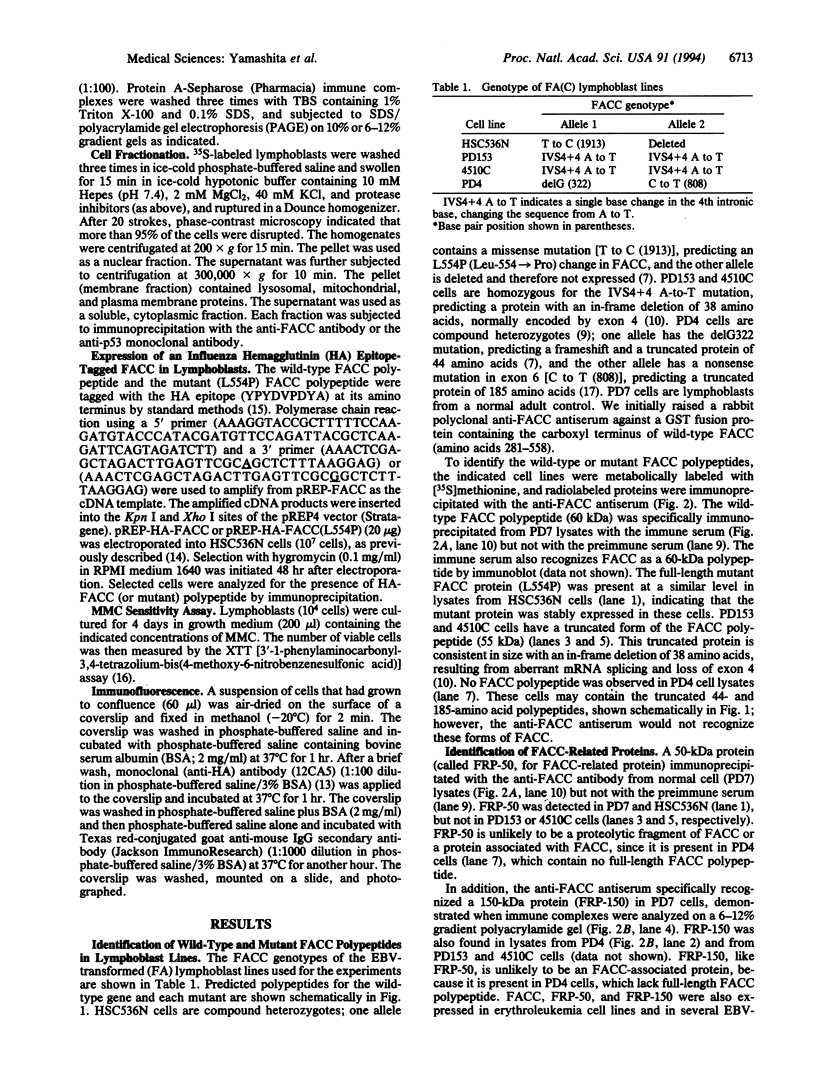
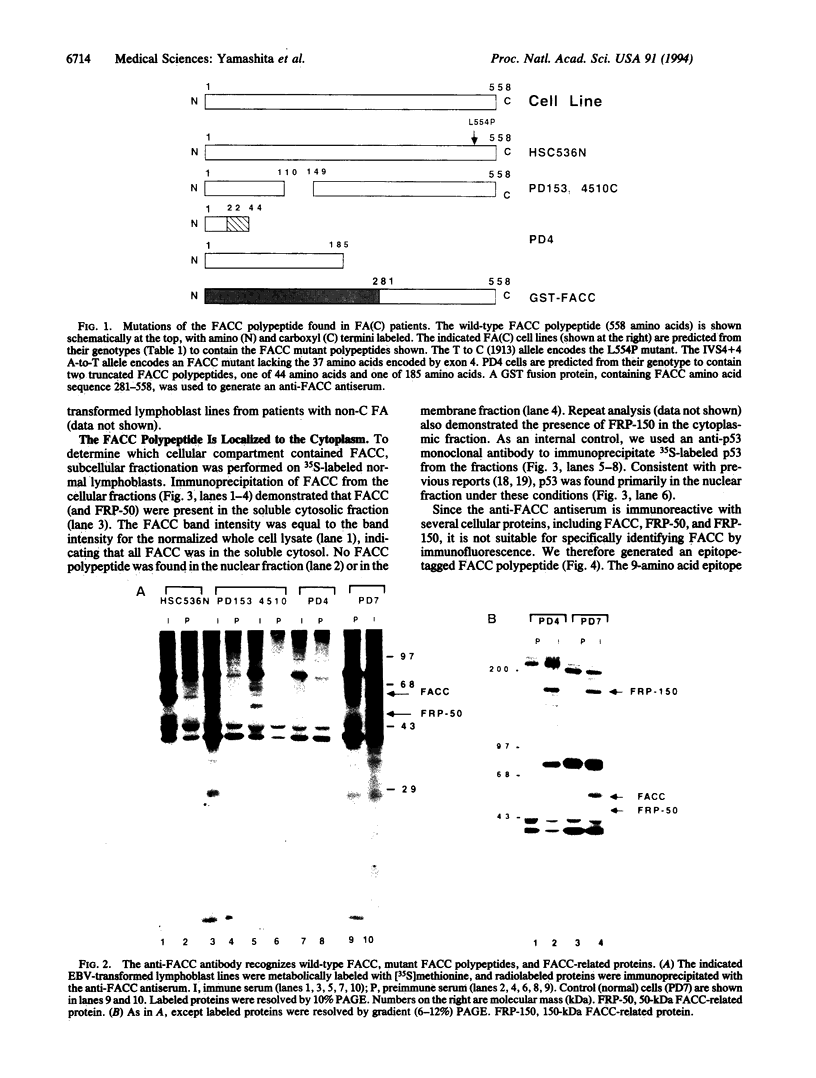
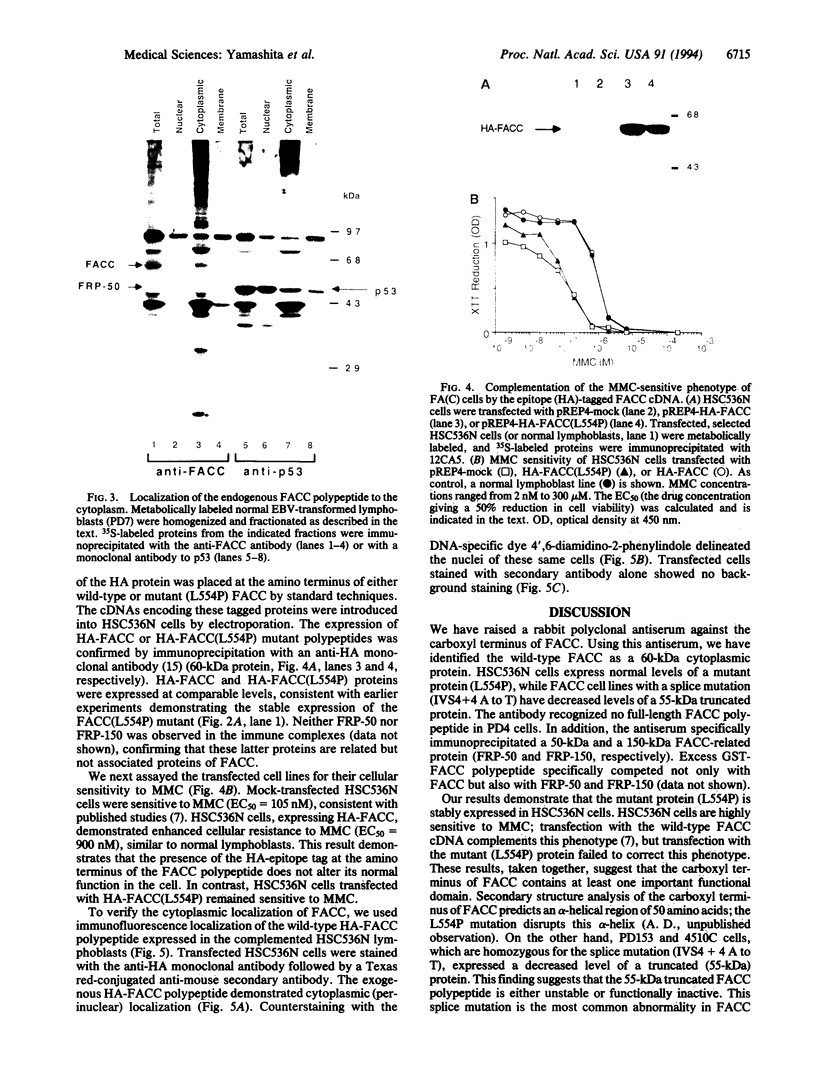
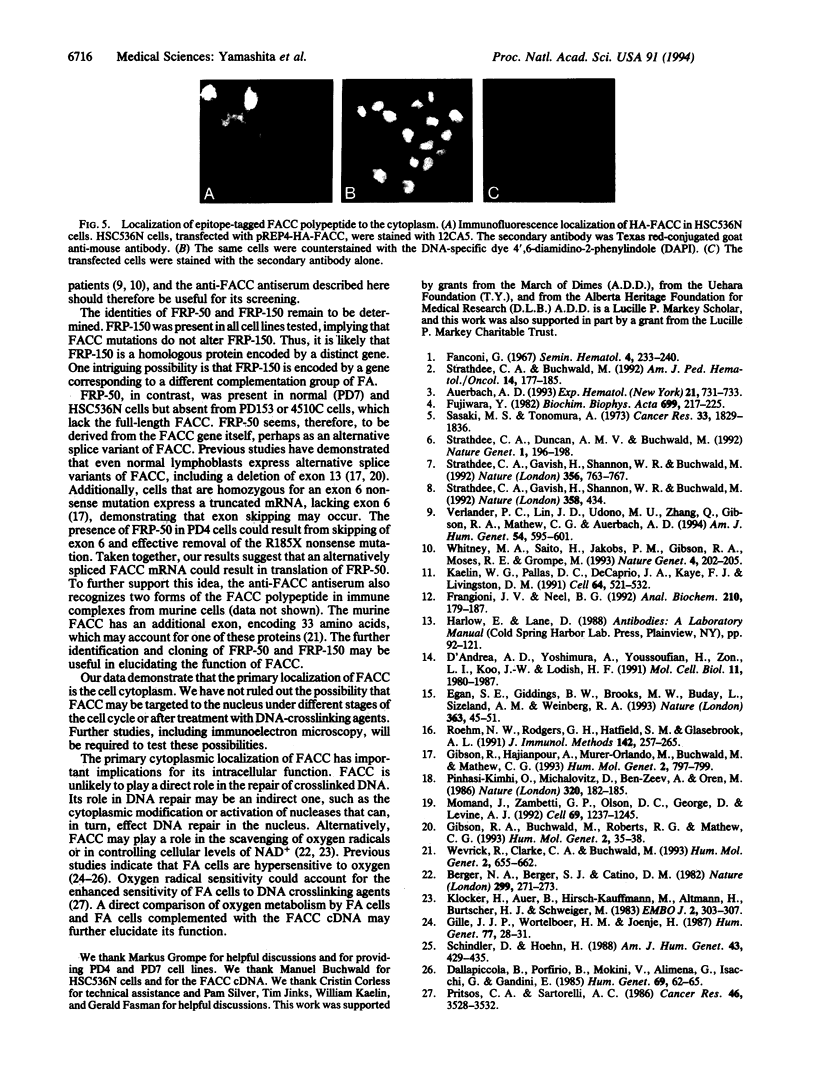
Images in this article
Selected References
These references are in PubMed. This may not be the complete list of references from this article.
- Auerbach A. D. Fanconi anemia diagnosis and the diepoxybutane (DEB) test. Exp Hematol. 1993 Jun;21(6):731–733. [PubMed] [Google Scholar]
- Berger N. A., Berger S. J., Catino D. M. Abnormal NAD+ levels in cells from patients with Fanconi's anaemia. Nature. 1982 Sep 16;299(5880):271–273. doi: 10.1038/299271a0. [DOI] [PubMed] [Google Scholar]
- D'Andrea A. D., Yoshimura A., Youssoufian H., Zon L. I., Koo J. W., Lodish H. F. The cytoplasmic region of the erythropoietin receptor contains nonoverlapping positive and negative growth-regulatory domains. Mol Cell Biol. 1991 Apr;11(4):1980–1987. doi: 10.1128/mcb.11.4.1980. [DOI] [PMC free article] [PubMed] [Google Scholar]
- Dallapiccola B., Porfirio B., Mokini V., Alimena G., Isacchi G., Gandini E. Effect of oxidants and antioxidants on chromosomal breakage in Fanconi anemia lymphocytes. Hum Genet. 1985;69(1):62–65. doi: 10.1007/BF00295530. [DOI] [PubMed] [Google Scholar]
- Egan S. E., Giddings B. W., Brooks M. W., Buday L., Sizeland A. M., Weinberg R. A. Association of Sos Ras exchange protein with Grb2 is implicated in tyrosine kinase signal transduction and transformation. Nature. 1993 May 6;363(6424):45–51. doi: 10.1038/363045a0. [DOI] [PubMed] [Google Scholar]
- Fanconi G. Familial constitutional panmyelocytopathy, Fanconi's anemia (F.A.). I. Clinical aspects. Semin Hematol. 1967 Jul;4(3):233–240. [PubMed] [Google Scholar]
- Frangioni J. V., Neel B. G. Solubilization and purification of enzymatically active glutathione S-transferase (pGEX) fusion proteins. Anal Biochem. 1993 Apr;210(1):179–187. doi: 10.1006/abio.1993.1170. [DOI] [PubMed] [Google Scholar]
- Fujiwara Y. Defective repair of mitomycin C crosslinks in Fanconi's anemia and loss in confluent normal human and xeroderma pigmentosum cells. Biochim Biophys Acta. 1982 Dec 31;699(3):217–225. doi: 10.1016/0167-4781(82)90110-5. [DOI] [PubMed] [Google Scholar]
- Gibson R. A., Buchwald M., Roberts R. G., Mathew C. G. Characterisation of the exon structure of the Fanconi anaemia group C gene by vectorette PCR. Hum Mol Genet. 1993 Jan;2(1):35–38. doi: 10.1093/hmg/2.1.35. [DOI] [PubMed] [Google Scholar]
- Gibson R. A., Hajianpour A., Murer-Orlando M., Buchwald M., Mathew C. G. A nonsense mutation and exon skipping in the Fanconi anaemia group C gene. Hum Mol Genet. 1993 Jun;2(6):797–799. doi: 10.1093/hmg/2.6.797. [DOI] [PubMed] [Google Scholar]
- Gille J. J., Wortelboer H. M., Joenje H. Antioxidant status of Fanconi anemia fibroblasts. Hum Genet. 1987 Sep;77(1):28–31. doi: 10.1007/BF00284708. [DOI] [PubMed] [Google Scholar]
- Kaelin W. G., Jr, Pallas D. C., DeCaprio J. A., Kaye F. J., Livingston D. M. Identification of cellular proteins that can interact specifically with the T/E1A-binding region of the retinoblastoma gene product. Cell. 1991 Feb 8;64(3):521–532. doi: 10.1016/0092-8674(91)90236-r. [DOI] [PubMed] [Google Scholar]
- Klocker H., Auer B., Hirsch-Kauffmann M., Altmann H., Burtscher H. J., Schweiger M. DNA repair dependent NAD+ metabolism is impaired in cells from patients with Fanconi's anemia. EMBO J. 1983;2(3):303–307. doi: 10.1002/j.1460-2075.1983.tb01423.x. [DOI] [PMC free article] [PubMed] [Google Scholar]
- Momand J., Zambetti G. P., Olson D. C., George D., Levine A. J. The mdm-2 oncogene product forms a complex with the p53 protein and inhibits p53-mediated transactivation. Cell. 1992 Jun 26;69(7):1237–1245. doi: 10.1016/0092-8674(92)90644-r. [DOI] [PubMed] [Google Scholar]
- Pinhasi-Kimhi O., Michalovitz D., Ben-Zeev A., Oren M. Specific interaction between the p53 cellular tumour antigen and major heat shock proteins. Nature. 1986 Mar 13;320(6058):182–184. doi: 10.1038/320182a0. [DOI] [PubMed] [Google Scholar]
- Pritsos C. A., Sartorelli A. C. Generation of reactive oxygen radicals through bioactivation of mitomycin antibiotics. Cancer Res. 1986 Jul;46(7):3528–3532. [PubMed] [Google Scholar]
- Roehm N. W., Rodgers G. H., Hatfield S. M., Glasebrook A. L. An improved colorimetric assay for cell proliferation and viability utilizing the tetrazolium salt XTT. J Immunol Methods. 1991 Sep 13;142(2):257–265. doi: 10.1016/0022-1759(91)90114-u. [DOI] [PubMed] [Google Scholar]
- Sasaki M. S., Tonomura A. A high susceptibility of Fanconi's anemia to chromosome breakage by DNA cross-linking agents. Cancer Res. 1973 Aug;33(8):1829–1836. [PubMed] [Google Scholar]
- Schindler D., Hoehn H. Fanconi anemia mutation causes cellular susceptibility to ambient oxygen. Am J Hum Genet. 1988 Oct;43(4):429–435. [PMC free article] [PubMed] [Google Scholar]
- Strathdee C. A., Buchwald M. Molecular and cellular biology of Fanconi anemia. Am J Pediatr Hematol Oncol. 1992 May;14(2):177–185. doi: 10.1097/00043426-199205000-00015. [DOI] [PubMed] [Google Scholar]
- Strathdee C. A., Duncan A. M., Buchwald M. Evidence for at least four Fanconi anaemia genes including FACC on chromosome 9. Nat Genet. 1992 Jun;1(3):196–198. doi: 10.1038/ng0692-196. [DOI] [PubMed] [Google Scholar]
- Strathdee C. A., Gavish H., Shannon W. R., Buchwald M. Cloning of cDNAs for Fanconi's anaemia by functional complementation. Nature. 1992 Apr 30;356(6372):763–767. doi: 10.1038/356763a0. [DOI] [PubMed] [Google Scholar]
- Strathdee C. A., Gavish H., Shannon W. R., Buchwald M. Cloning of cDNAs for Fanconi's anaemia by functional complementation. Nature. 1992 Jul 30;358(6385):434–434. doi: 10.1038/358434a0. [DOI] [PubMed] [Google Scholar]
- Verlander P. C., Lin J. D., Udono M. U., Zhang Q., Gibson R. A., Mathew C. G., Auerbach A. D. Mutation analysis of the Fanconi anemia gene FACC. Am J Hum Genet. 1994 Apr;54(4):595–601. [PMC free article] [PubMed] [Google Scholar]
- Wevrick R., Clarke C. A., Buchwald M. Cloning and analysis of the murine Fanconi anemia group C cDNA. Hum Mol Genet. 1993 Jun;2(6):655–662. doi: 10.1093/hmg/2.6.655. [DOI] [PubMed] [Google Scholar]
- Whitney M. A., Saito H., Jakobs P. M., Gibson R. A., Moses R. E., Grompe M. A common mutation in the FACC gene causes Fanconi anaemia in Ashkenazi Jews. Nat Genet. 1993 Jun;4(2):202–205. doi: 10.1038/ng0693-202. [DOI] [PubMed] [Google Scholar]





